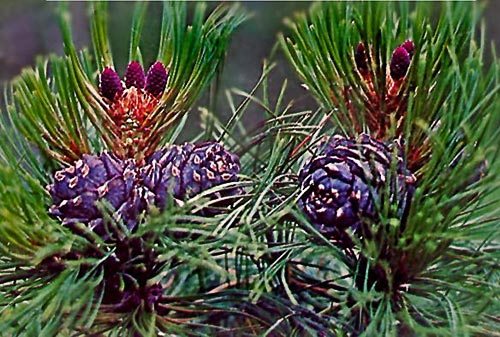Relatives
Pinus sibirica Du Tour - Siberian Pine.
Taxonomic position.
Family Pinaceae Lindl. genus Pinus L.Morphology and biology.
Large evergreen tree up to 35-45 m tall and up to 1.8 m diameter in lower part of trunk; root system with developed taproot and firm, widely prostrate lateral roots; bark brownish-grey; crown of free-growing trees broad, dense, oval, in forests apical, in lower part with dry boughs; young branches with long fulvous hairs. Leaves in bunches of 5, 6.13 cm long and 0.8-1.2 mm wide, triquetrous, slightly notched at margins, three resin canals, located in leaf flesh, opposite leaf corners; buds not resinous, orbicular, long-acuminate, covered with long, red-brown scales. Cones erect, indehiscent, light brown, 6-13 cm long and 5-8 cm wide, their scales densely adpressed, with short and rigid hairs on surface; seeds dark brown, 10.14 mm long and 6.10 mm wide, obliquely obovoid, smooth. Monoecious, anemophilous, ornitho- and partly zoochore.Distribution.
European part (northeastern), Urals, West Siberia, Altai, East Siberia (central and southern parts); Northern Mongolia.Ecology.
One of main forest-forming species of dark coniferous taiga. Occurs up to upper montane zone (above forest limit in trailing shrub form).Use and economic value.
Valuable timber tree and nuciferous tree.References:
Sokolov SI., Svjaseva OA., Kubli VA. 1977. Ranges of trees and shrubs of the USSR. V.1. Leningrad: Nauka. 240 p. (In Russian).Tolmachev AI., ed. 1974. Flora of the North-East of European part of the USSR. V.1. Leningrad: Nauka. 275 p. (In Russian).
Krasnoborov IM., ed. 1988. Flora of Siberia. V.1. Lycopodiaceae - Hydrocharitaceae. Novosibirsk: Nauka. 199 p. (In Russian).


